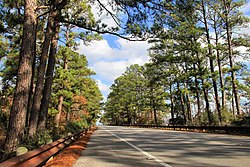Lost Pines Forest
| Lost Pines Forest | |
|---|---|
| Forest | |

Part of the Lost Pines Forest along State Highway 21 near Bastrop.
|
|
| Location of Lost Pines | |
| Coordinates: 30°6′43″N 97°19′1″W / 30.11194°N 97.31694°WCoordinates: 30°6′43″N 97°19′1″W / 30.11194°N 97.31694°W |
The Lost Pines Forest is a 13-mile (21 km) belt of loblolly pines (Pinus taeda) in the U.S. state of Texas, near the town of Bastrop. The stand of pines is unique in Texas because it is a disjunct population of trees that is more than 100 miles (160 km) separated from, and yet closely genetically related to, the vast expanse of pine trees of the Piney Woods region that covers parts of Texas, Arkansas, Louisiana, and Oklahoma.
The forest is thought to have originated as part of a much larger pine forest that shrank in size during the last glacial period of the . It was first described by early Spanish explorer Domingo Terán de los Ríos in his expedition along the Colorado River in 1691 and later by Stephen F. Austin and other settlers drawn to the area by the land grants awarded by the Mexican government. The Bastrop Steam Mill Company began lumbering in the Lost Pines in 1838, followed by Higgins Mill in 1840. By 1870 the population for Bastrop County reached 11,000 people, which increased demands for timber. Extensive logging of the Lost Pines occurred around 1880, but the forested land area remained largely intact. The Lost Pines Forest occupied 36,400 hectares in 1880 and of this, 34,400 hectares remained in 1952.
A portion of the Lost Pines is located inside the boundaries of Bastrop State Park and Buescher State Park, which ensure the trees are protected from development and logging. The original Lost Pines Forest sampled within the Bastrop State Park has the same levels of genetic diversity found in the larger, more continuous East Texas Piney Woods and in the rest of the extensive Pinus taeda forests west of the Mississippi River Valley. Thus the original Lost Pines population is not genetically depauperate despite its geographic separation from the larger, more continuous Pinus taeda forest. Pinus taeda can live as long as 300 to 400 years.
...
Wikipedia

